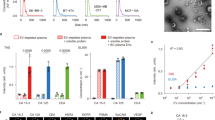Abstract
Indoleamine-2,3-dioxygenase (IDO) has been established as a normal mechanism of peripheral tolerance and immunosuppression. Besides, malignant tumors release microvesicles (MV) related with tumor dissemination. The aims of this study were to determine the expression of IDO in breast cancer and circulating microvesicles from breast cancer patients and to perform an in silico analysis to find genes co-expressed to IDO. One hundred and twenty-two tissue and serum breast samples (91 malignant, 21 benign, and 10 normal), and MCF7, MDA-MB-231, and T47D breast cancer cell lines were included. Standard immunohistochemistry (IHC), immunocytochemistry (ICC), Western blot (WB), and RT-PCR were employed. Microvesicle isolation from plasma samples was obtained by serial centrifugation and ultracentrifugation. By IHC, 60 % breast cancer, 43 % benign, and 20 % normal samples were positive. Significant differences were found among normal, benign, and malignant samples. Breast cancer stages I, II, and III expressed IDO in 42, 66, and 71 % of samples, respectively, while breast cancer cell lines also reacted; by WB, 9/25 microvesicles fractions showed bands at 42 kD. In silico analysis of IDO 1 gene expression in breast cancer showed its association with several genes related to immune response and apoptosis. Moreover, IDO and co-expressed genes were found predominately in basal and erbB2 subtypes. The cumulative data indicate a high expression of IDO in breast cancer which increased with higher stages. Furthermore, IDO was found in association with circulating breast cancer MV, while experimental and in silico gene expression revealed that IDO was mainly expressed in a triple-negative subgroup.





Similar content being viewed by others
References
Mellor AL, Munn DH. Tryptophan catabolism and T-cell tolerance: immunosuppression by starvation? Immunol Today. 1999;20(10):469–73.
Munn DH, Shafizadeh E, Attwood JT, Bondarev I, Pashine A, Mellor AL. Inhibition of T cell proliferation by macrophage tryptophan catabolism. J Exp Med. 1999;189(9):1363–72.
Taylor MW, Feng GS. Relationship between interferon-gamma, indoleamine 2,3-dioxygenase, and tryptophan catabolism. FASEB J. 1991;5(11):2516–22. Review.
Munn DH, Mellor AL. Indoleamine 2,3-dioxygenase and tumor-induced tolerance. J Clin Invest. 2007;117(5):1147–54. Review.
Jasperson LK, Bucher C, Panoskaltsis-Mortari A, Mellor AL, Munn DH, Blazar BR. Inducing the tryptophan catabolic pathway, indoleamine 2,3-dioxygenase (IDO), for suppression of graft-versus-host disease (GVHD) lethality. Blood. 2009;114(24):5062–70.
Munn DH, Mellor AL. Indoleamine 2,3 dioxygenase and metabolic control of immune responses. Trends Immunol. 2013;34(3):137–43. doi:10.1016/j.it.2012.10.001.
Bauer TM, Jiga LP, Chuang JJ, Randazzo M, Opelz G, Terness P. Studying the immunosuppressive role of indoleamine 2,3-dioxygenase: tryptophan metabolites suppress rat allogeneic T-cell responses in vitro and in vivo. Transpl Int. 2005;18(1):95–100.
Raulet DH. Interplay of natural killer cells and their receptors with the adaptive immune response. Nat Immunol. 2004;5(10):996–1002. Review.
Bauernhofer T, Kuss I, Henderson B, Baum AS, Whiteside TL. Preferential apoptosis of CD56dim natural killer cell subset in patients with cancer. Eur J Immunol. 2003;33(1):119–24.
Song H, Park H, Kim YS, Kim KD, Lee HK, Cho DH, et al. l-kynurenine-induced apoptosis in human NK cells is mediated by reactive oxygen species. Int Immunopharmacol. 2011;11(8):932–8.
Whiteside TL. Tumour-derived exosomes or microvesicles: another mechanism of tumour escape from the host immune system? Br J Cancer. 2005;92(2):209–11.
Croce MV, Isla-Larrain MT, Demichelis SO, Gori JR, Price MR, Segal-Eiras A. Tissue and serum MUC1 mucin detection in breast cancer patients. Breast Cancer Res Treat. 2003;81(3):195–207.
Towbin H, Staehelin T, Gordon J. Electrophoretic transfer of proteins from polyacrylamide gels to nitrocellulose sheets: procedure and some applications. Proc Natl Acad Sci U S A. 1979;76:4350–4.
Chen X, Li J, Gray WH, Lehmann BD, Bauer JA, Shyr Y, et al. TNBCtype: a subtyping tool for triple-negative breast cancer. Cancer Informat. 2012;11:147–56. doi:10.4137/CIN.S9983.
Sabatier R, Finetti P, Cervera N, Lambaudie E, et al. A gene expression signature identifies two prognostic subgroups of basal breast cancer. Breast Cancer Res Treat. 2011;126(2):407–20. PMID: 20490655.
Lehmann BD, Bauer JA, Chen X, Sanders ME, Chakravarthy AB, Shyr Y, et al. Identification of human triple-negative breast cancer subtypes and preclinical models for selection of targeted therapies. J Clin Invest. 2011;121(7):2750–67. doi:10.1172/JCI45014.
Wang H, Pan K, Xia JC. Interaction of indoleamine-2,3-dioxygenase and CD4+CD25+ regulatory T cells in tumor immune escape. Ai Zheng. 2009;28(2):184–7. Review.
Munn DH. Blocking IDO, activity to enhance anti-tumor immunity. Front Biosci (Elite Ed). 2012;4:734–45. Review.
Yu J, Sun J, Wang SE, Li H, Cao S, Cong Y, et al. Upregulated expression of indoleamine 2,3-dioxygenase in primary breast cancer correlates with increase of infiltrated regulatory T cells in situ and lymph node metastasis. Clin Dev Immunol. 2011;2011:469135. doi:10.1155/2011/469135.
Jacquemier J, Bertucci F, Finetti P, Esterni B, Charafe-Jauffret E, Thibult ML, et al. High expression of indoleamine 2,3-dioxygenase in the tumour is associated with medullary features and favourable outcome in basal-like breast carcinoma. Int J Cancer. 2012;130(1):96–104. doi:10.1002/ijc.25979.
Soliman H, Rawal B, Fulp J, Lee JH, Lopez A, Bui MM, et al. Analysis of indoleamine 2,3-dioxygenase (IDO 1) expression in breast cancer tissue by immunohistochemistry. Cancer Immunol Immunother. 2013;62(5):829–37. doi:10.1007/s00262-013-1393-y.
Taylor DD, Gerçel-Taylor C. Tumour-derived exosomes and their role in cancer-associated T-cell signalling defects. Br J Cancer. 2005;92(2):305–11.
Whiteside TL. Immune modulation of T-cell and NK (natural killer) cell activities by TEXs (tumour-derived exosomes). Biochem Soc Trans. 2013;41(1):245–51. doi:10.1042/BST20120265. Review.
Acknowledgments
We thank Miss María Emilia Cermignani for performing English corrections of the manuscript, and to Miss Yamila Blas and Mr. Juan Carlos Molina for the technical assistance.
Conflicts of interest
None
Financial support
This study was supported by the National University of La Plata, Argentina.
Disclosure
Prof. María Virginia Croce, Dr. Marina Isla Larrain, and Martín E. Rabassa are members of the research career of the Comisión de Investigaciones Científicas de la Provincia de Buenos Aires (CIC/PBA).
Author information
Authors and Affiliations
Corresponding author
Additional information
M. T. Isla Larrain and M. E. Rabassa contributed equally in this study.
Rights and permissions
About this article
Cite this article
Isla Larrain, M.T., Rabassa, M.E., Lacunza, E. et al. IDO is highly expressed in breast cancer and breast cancer-derived circulating microvesicles and associated to aggressive types of tumors by in silico analysis. Tumor Biol. 35, 6511–6519 (2014). https://doi.org/10.1007/s13277-014-1859-3
Received:
Accepted:
Published:
Issue Date:
DOI: https://doi.org/10.1007/s13277-014-1859-3




